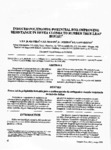Please use this identifier to cite or link to this item:
http://www.alice.cnptia.embrapa.br/alice/handle/doc/667197| Title: | Induced polyploidy potential for improving resistance in Hevea clones to rubber tree leaf blight. |
| Authors: | JUNQUEIRA, N. T. V.  MORAES, V. H. F.   LIEBEREI, R.   GASPAROTTO, L.   |
| Affiliation: | EMBRAPA-CPAA; Institut fur Angewandte Botanik.; LUADIR GASPAROTTO, CPAA. |
| Date Issued: | 1993 |
| Citation: | Fitopatologia Brasileira, v. 18, n. 1, p. 12-18, mar. 1993. |
| Description: | Components of resistance that reduce the epidemic rate of rubber tree leaf blight, have been evaluated on colchicine-induced polyploids (CIP) Hevea clones and on their respective natural diploids after inoculation of virulente Microcyclus ulei isolates to the diploid clones. SomeCIP clones have presented high level of resistance in comparison with their susceptible diploid clones, whereas other CIP clones were susceptible. The polyploid plant inherent factors controlling the resistanceto M. ulei and the induced polyploid potential for rubber tree breeding aiming at resistance to leaf blight are discussed. |
| Thesagro: | Espécie Doença Folha Fungo Hevea Melhoramento Microcyclus Ulei Resistência Seringueira |
| NAL Thesaurus: | breeding leaves polyploidy |
| Keywords: | Mal-das-folhas Poliploide Brasil Amazonas Rubber tree Species Fungal diseases South American leaf blight SALB Resistance |
| Type of Material: | Artigo de periódico |
| Access: | openAccess |
| Appears in Collections: | Artigo em periódico indexado (CPAA)  |
Files in This Item:
| File | Description | Size | Format | |
|---|---|---|---|---|
| p.1218.pdf | 5,72 MB | Adobe PDF |  View/Open |









